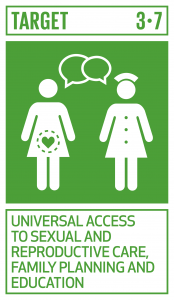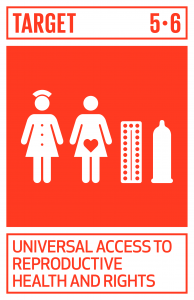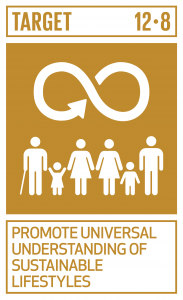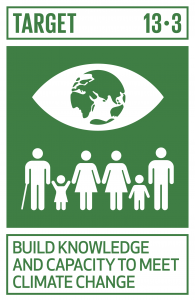SDG 4 – “Ensure inclusive and equitable quality education and promote lifelong learning opportunities for all” – is made up of a global monitoring framework of 10 targets and, starting in 2020, 12 indicators. Education is considered a fundamental human right1 and a core enabler for sustainable development.2
This goal promotes inclusive access to education for both genders as well as quality of services. SDG 4 encompasses early childhood education (4.2), primary and secondary education (4.1), and vocational and tertiary education (4.3). Attention is paid to ensuring students have work-ready skills (4.4), in addition to focusing on basics like literacy and numeracy (4.6) and education for the advancement of sustainable development (4.7). Access to quality educational infrastructure (4.A), quality educational programs (4.B) and qualified teachers (4.C) feature in the means of implementation targets.
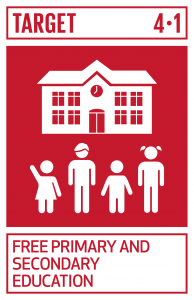
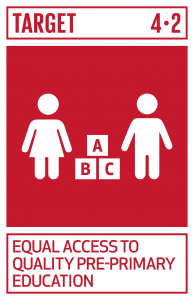
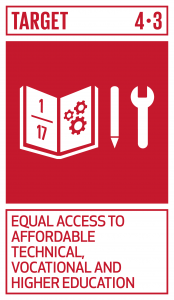
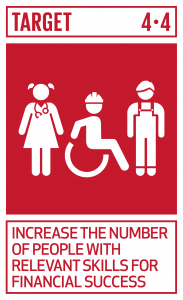

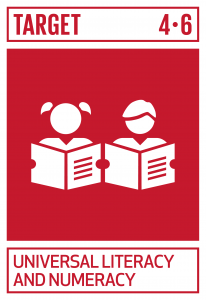
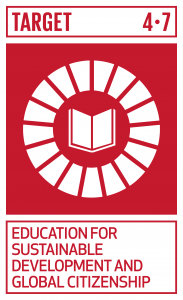
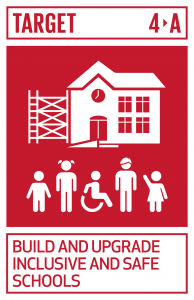
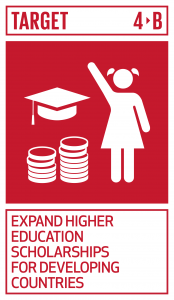
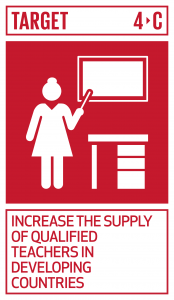
This SDG explicitly addresses inequality. Target 4.5 refers to gender disparities in education and unequal access for vulnerable groups. Targets 4.1, 4.2, 4.3, 4.4, 4.6, and 4.A mention gender and/or vulnerable groups such as people with disabilities. In addition to drawing attention to inequality, this means that this level of disaggregation is the starting point for data collected for this SDG. This is important because highly disaggregated data are necessary to fully understand the complexities of education, and allows help to be provided where it is needed most.
SDG 4 will be reviewed at the 2019 High-Level Political Forum, along with SDGs 8 (Decent work and economic growth), 10 (Reduced inequalities), 13 (Climate action), and 16 (Peace, justice and strong institutions). SDG 17 (Partnerships for the goals) is reviewed annually.
Context
SDG 4 expands on the earlier Millennium Development Goal (MDG) 2 (Achieving universal primary education).3 Unfinished aspects of the MDG agenda on education are included in Targets 4.1 (access to primary and secondary education), 4.2 (access to early childhood education), 4.5 (gender parity), and 4.6 (literacy and numeracy skills).4 SDG 4 also builds on the Education for All Goals adopted in 2000.5
With such an established institutional history, it has been possible to identify the improvements needed to develop an appropriate monitoring framework for SDG 4, particularly in the need for multidimensionality and nationally-comparable data.6. Keeping this in mind, the international community also adopted “Education 2030: Incheon Declaration and Framework for Action for the implementation of Sustainable Development Goal 4” (the Incheon Declaration) in 2015. The Incheon Declaration represents the commitments of the international education community to the 2030 Agenda and SDG 4.7 It is intended to help with implementing SDG 4.
Significant work is still necessary to meet the ambitions of SDG 4. Projections suggest that lower-middle income countries, which make up four of the five LMCs, could be many years behind schedule.8 Universal lower and upper secondary education might not happen until 2066 and 2088, respectively.9 This is not to say that education is not considered important; in fact, the value placed on education has been a trademark of Southeast Asia.10 Despite this, ensuring quality education continues to require work.11
Education appears as a standalone goal in the SDGs, but is also featured in SDG targets 3.7 (family planning education), 5.6 (countries with laws guaranteeing women’s access to education), 8.6 (reducing the number of youth not in school), 12.8 (ensuring access to information on sustainable development), and 13.3 (improving education on climate change).12
Ultimately, education is interlinked with successfully implementing all of the SDGs.13 The provision of basic education is the foundation for social mobility and human development.14 For instance, education is critical to escaping poverty (SDG 1), preventing malnutrition (SDG 2), improving health (SDG 3), and voicing concerns and participating in public institutions (SDG 16).15
Regionalisation and localisation
ASEAN cooperation on education has been on the organisation’s agenda since 2005, when the ASEAN education ministers decided to convene on a regular basis.16 Since then, education has been both the subject of and a key part of a number of policies and plans for the ASEAN countries. Currently, the ASEAN Plan of Action on Science, Technology and Innovation (APASTI) 2016‐2025, and the 2015 Kuala Lumpur Declaration on Higher Education are being implemented. In addition, the education ministers have adopted a follow-up work plan for education for the years 2016–2020,17 which overlaps with seven of the 10 SDG 4 targets.18 Access to education is also used in the ASEAN Socio-Cultural Community (ASCC) Blueprint 2025 as a tool to develop a more inclusive, sustainable, and dynamic ASEAN community.19 This Blueprint is in part rooted in the Cha Am Hua Hin Declaration on Strengthening Cooperation on Education to Achieve an ASEAN Caring and Sharing Community.20
Education is often the biggest commitment in national budgets and a key recipient in external assistance for most Southeast Asian states.21 However, not all countries are able to effectively provide full access to quality education. In the LMCs, it is only in Vietnam that almost all children finish primary school.22 For the other countries, the key factors limiting access to primary education are generally economic (such as no money to support education or children being required to help on farms or earn money) and cultural attitudes (such as boys being given priority in education and girls being expected to stay at home).23
The number of graduates from tertiary educational institutions is increasing in the LMCs. Growth of 25.4 percent per annum took place in Lao PDR from 2000 to 2013, 25.3 percent in Cambodia from 1999 to 2011, and 23.1 percent in Myanmar from 2007 to 2012.24 However, many graduates do not yet have the skills required to be work-ready.25 Development agencies such as USAID have begun working to decrease this gap through the education pillar of its Lower Mekong Initiative.
Not all people have equal access to education. For instance, women are less likely to complete their education. While at the primary level, all the LMCs have achieved or mostly achieved gender parity, the view is different (for those countries where data is available) at the tertiary level.26 Women are also less likely to choose education in science, technology, engineering, and mathematics.27 For instance, in Lao PDR in 2016, only 1.5 percent of female students in tertiary education were enrolled in a natural sciences, mathematics or statistics program, and in Vietnam the number was just 0.6 percent.28 A gap also exists between rural and urban populations. Rural students are much less likely to be able to access and stay in education, and this ranges across the LMCs. For instance, urban Thai students attend school for 12 years and rural students attend for 11, compared to urban Lao students who attend for 12 years while rural students attend for under five years.29
To support coordination on SDG 4 in the Asia-Pacific Region, a regional thematic working group called the Asia-Pacific Regional TWG on Education 2030+ was established in 2015.30 It also makes recommendations on partnerships, and provides technical support for review and follow up.31
Means of implementation
The three means of implementation targets for SDG 4 focus on physical, financial and human resources – upgrading education facilities (4.A), expanding the number of scholarships available to developing countries (4.B) and increasing the supply of qualified teachers (4.C). Implicit in achieving these goals is the need for sufficient financing. It is understood that a lack of adequate and equitable finance was a key reason why the world fell short of achieving the Education for All goals.32 While SDG 4 does not specifically focus on financing, the Incheon Declaration asks countries to allocate at least 4 percent of GDP and at least 15 percent of total government expenditure to education.
In addition to official development assistance (4.B.1), public-private partnerships can help provide the necessary financing, especially for upgrading education facilities. However, governments need to think beyond simply procuring a product. A project called “One Tablet per Child” that gave tablet computers to first graders in Thailand was initially seen as a project with potential, until some 30 percent of the issued tablets were found to be broken, and the private producer of the tablets was unable to meet its contract. Beyond procurement, public-private partnerships require transparency and monitoring.33
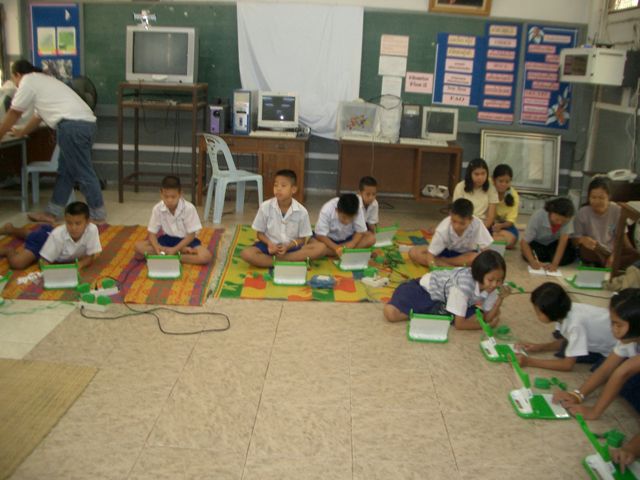
Educational tools like laptops, tablets and access to the internet are important for young students today, but a project to provide Thai students with these tools proved problematic. Photo by OLPC, Wikimedia Commons. Licensed under CC BY 2.5.
There are scholarship programs for ASEAN students to pursue higher education funded by official development aid (4.B) from sources such as Canada and the European Union. As an example of south-south partnerships, Singapore offers scholarships to students from other ASEAN countries on a rotating basis to study in Singapore. Another ASEAN partnership, the ASEAN Teacher’s Education Network, promotes quality teacher education (4.C). LMC members include the Vietnam National University Ho Chi Minh City, Kasetsart University (Thailand), Yangon Institute of Education (Myanmar), the National University of Laos, and the National Institute of Education (Cambodia).
Follow-up and review, monitoring and evaluation
The SDG 4 indicators are made up of global and thematic indicators. The international education community, with the assistance of the Technical Cooperation Group on the Indicators for SDG 4 – Education 2030, has developed an additional 32 thematic indicators to cover the breadth of education. Twenty two are mapped onto both the SDG 4 targets and the Education 2030 agenda and form part of the core list of indicators.34 The remaining 10 are not part of the core list.35
UNESCO has been the monitoring institution for both the education-related MDGs and the Education for All Goals, and will continue to be the custodian agency for nine of the 12 SDG 4 indicators. The indicators range in readiness, with five at Tier I (4.1.1, 4.1.2, 4.2.2, 4.5.1 depending on the indices, and 4.B.1) and eight at Tier II (4.2.1, 4.3.1, 4.4.1, 4.5.1 depending on the indices, 4.6.1, 4.7.1, 4.a.1, and 4.c.1).
| Indicator | Tier | Custodian Agency | Notes |
|---|---|---|---|
| 4.1.1 | I | UNESCO-UIS | -- |
| 4.1.2 | I (provisional) | -- | -- |
| 4.2.1 | II | UNICEF | -- |
| 4.2.2 | I | UNESCO-UIS | -- |
| 4.3.1 | II | UNESCO-UIS | -- |
| 4.4.1 | II | UNESCO-UIS, ITU | -- |
| 4.5.1 | I/II, depending on indice | UNESCO-UIS | -- |
| 4.6.1 | II | UNESCO-UIS | -- |
| 4.7.1 | II | UNESCO-UIS | -- |
| 4.A.1 | II | UNESCO-UIS | -- |
| 4.B.1 | I | OECD | -- |
| 4.C.1 | II | UNESCO-UIS | -- |
The Incheon Declaration mandates that the Global Education Monitoring (GEM) Report, to be published by UNESCO, monitor and assess SDG 4.36 It is a continuation of what was previously known as the Global Monitoring Report under the Education for All framework. 37 The GEM Report has also developed the World Inequality Database on Education (WIDE) to help draw attention to the levels of inequality in education across and within countries.38
While globally the UN considers there to be sufficient data for five indicators, in the Mekong Region data is not available for all of the countries, and data is not always up to date. There are also limitations in the data collected. For instance, while there are figures available on how many children of pre-primary school age are attending school (4.2.2), available data sources do not yet allow a reliable global estimate of how many children benefit from at least one year of pre-primary education.39 Available data sources also do not fully capture the diversity of services providing learning opportunities for young children.40
| Country | Percentage of pupils over-age for grade (%) | Total enrolment in primary education | Gross enrolment ratio (GER) in primary education (total %) | Gross enrolment ratio (GER) in primary education male %) | Gross enrolment ratio (GER) in primary education (female %) | Out-of-school children |
|---|---|---|---|---|---|---|
| Cambodia | 22.9 z | 2179 | 117 | 117 | 116 | 95** |
| Lao PDR | 20.3 | 850 | 111 | 114 | 109 | 56 |
| Myanmar | 3.1 z | 5,177 z | 100 z | 101 z | 98 z | 284 z |
| Thailand | 3.7 | 5081 | 103 | 106 | 99 | 454 |
| Viet Nam | - | 7544 | 109 | 109 | 108 | 127** ,y |
A regional approach is the most practical way to properly monitor education systems and policies because regional partners have shared contexts. The tools for monitoring education require agreement on scope, coverage and frequency, in addition to national ownership. Better coordination is needed between existing global and regional monitoring bodies on education system diagnostic tools to address gaps and reduce overlaps.41
References
- 1. UN. 1948. Universal Declaration of Human Rights. Accessed June 21, 2018.
- 2. UN DESA. SDG-Education 2030 Steering Committee. Accessed June 21, 2018.
- 3. UNESCO-UIS. 2017. SDG 4 Monitoring: framework development. Accessed June 21, 2018.
- 4. Hiyashikawa, Maki. 2017. SDG4 – Education 2030 in Asia and the Pacific. Accessed June 25, 2018.
- 5. UNESCO-UIS. 2017. SDG 4 Monitoring: framework development. Accessed June 21, 2018.
- 6. Ibid.
- 7. UN. 2015. Education 2030: Incheon Declaration and Framework for Action for implementation of Sustainable Development Goal 4. Accessed June 21, 2018.
- 8. UNESCO. 2016. Global Education Monitoring Report 2016, Education for People and Planet: Creating Sustainable Futures for All. Accessed March 7, 2018.
- 9. Ibid.
- 10. UNESCAP. 2017. Southeast Asia Subregion Challenges and Priorities for SDG implementation. Accessed June 25, 2018.
- 11. Ibid.
- 12. UNESCO. 2017. Unpacking Sustainable Development Goal 4 Education 2030: Guide. Accessed June 21, 2018.
- 13. UN DESA. SDG-Education 2030 Steering Committee. https://sustainabledevelopment.un.org/index.php?page=view&type=30022&nr=100&menu=3170. Accessed June 21, 2018.
- 14. UNESCAP. 2017. Southeast Asia Subregion Challenges and Priorities for SDG implementation. Accessed June 25, 2018.
- 15. UN DESA. SDG-Education 2030 Steering Committee. https://sustainabledevelopment.un.org/index.php?page=view&type=30022&nr=100&menu=3170. Accessed June 21, 2018.
- 16. ASEAN. ASEAN Education Minister’s Meeting (ASED). Accessed June 22, 2018.
- 17. ASEAN Education Ministers. 2016. Joint Statement of the Ninth ASEAN Education Ministers Meeting (9th ASED). Accessed June 22, 2018.
- 18. Lanceta, Abigail C. ASEAN Cooperation on Education and the SDG 4. Accessed June 24, 2018.
- 19. ASEAN Secretariat. 2016. ASEAN Socio-Cultural Community Blueprint 2025. Accessed June 25, 2018.
- 20. ASEAN Secretariat. 2009. Cha Am Hua Hin Declaration on Strengthening Cooperation on Education to Achieve an ASEAN Caring and Sharing Community. http://www.asean.org/storage/images/archive/15thsummit/Declaration-Education.pdf. Accessed June 22, 2018.
- 21. ESCAP. 2017. Southeast Asia Subregion Challenges and Priorities for SDG implementation. Accessed June 25, 2018.
- 22. Ibid.
- 23. Ibid.
- 24. United Nations Economic and Social Commission for Asia and the Pacific. Statistical Yearbook for Asia and the Pacific 2015: 4 Quality Education. http://www.unescap.org/sites/default/files/SDGs_04_SYB2015.pdf. Accessed March 7, 2018.
- 25. Alexander, Hayley and David Felge. 2016. Lower Mekong Workforce Skills Gap Analysis and Implications for Regional Growth. Accessed March 7, 2018.
- 26. Education: Gross Graduation Ratio. Accessed March 8, 2018.
- 27. Global Education Monitoring Report Team. 2018. Global Education Monitoring Report Gender Review 2018: Meeting our Commitments to Gender Equality in Education. Accessed March 7, 2018.
- 28. Distribution of enrolment by field of study: tertiary education. Accessed March 7, 2018.
- 29. World Inequality Database on Education. Accessed March 8, 2018.
- 30. UNESCO. Regional Cooperation Mechanisms. https://en.unesco.org/education2030-sdg4/coordination/regional-cooperation-mechanisms. Accessed June 25, 2018.
- 31. Ibid.
- 32. UNESCO. 2016. Global Education Monitoring Report 2016, Education for People and Planet: Creating Sustainable Futures for All. Accessed March 7, 2018.
- 33. UNESCO. 2017/18. Global Education Monitoring Report, Accountability in Education: Meeting Our Commitments. Accessed, February 27, 2018.
- 34. UNESCO. SDG 4 Global and Thematic Indicator Lists. Accessed June 25, 2018.
- 35. Ibid.
- 36. UN. 2015. Education 2030: Incheon Declaration and Framework for Action for implementation of Sustainable Development Goal 4. Accessed June 21, 2018.
- 37. Ibid.
- 38. The GEM Report. About Us. Accessed June 25, 2018.
- 39. UNESCO. 2016. Global Education Monitoring Report 2016, Education for People and Planet: Creating Sustainable Futures for All. Accessed March 7, 2018.
- 40. Ibid.
- 41. Ibid.
